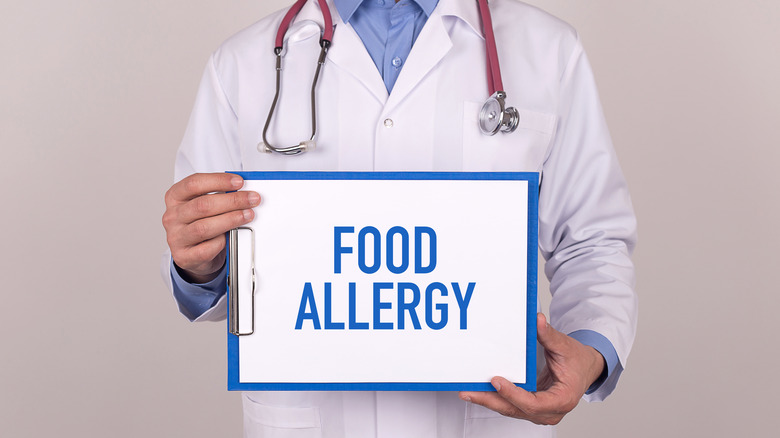What Experts Have To Say About Rising Food Allergy Rates
Serious food allergies have become seemingly omnipresent in modern society. It's become standard for servers to ask if any of the diners have allergies, especially since severe food allergies send someone to the emergency room every three minutes, per one study published by the Journal of Allergy & Clinical Immunology. According to Healthline, 6% of adults and 8% of children have food allergies, which means that ingesting certain foods can induce an abnormal and dangerous immune system response with symptoms like swelling, inflammation, hives, vomiting, and, in the most severe cases, anaphylactic shock or death.
The most common food allergies include cow's milk, eggs, tree nuts (which include brazil nuts, almonds, cashews, macadamia nuts, pistachios, pine nuts, and walnuts), peanuts, shellfish, soy, fish, and wheat. Recent food trends may reflect an increasing intolerance and uptick in deadly food allergies — but what's the cause behind the rising food allergy rates?
Theory 1: Impact of hygiene and the microbiome on food allergies
One recent deep dive into food allergies by Vox reports that there is no single cause behind the rise in food allergies in children and adults alike. Rather, it is likely due to a mix of varying factors at play. One of the theories is the "hygiene hypothesis," which, according to an article published in Clinical & Experimental Immunology, observes that the more developed a country is, the lower its infection rate, but the higher the rate of autoimmune disease. Put plainly, the fewer germs and bacteria children come into contact with, the more reactive their immune systems will be to harmless allergens, thus triggering reactions.
However, some scientists have spoken against the hygiene hypothesis, arguing that cleaning and disinfecting less won't help the immune system but will only lead to more infections. Graham Rook, a microbiology professor at University London College, stated to the Proceedings of the National Academy of Sciences of the United States of America (PNAS), "We know an awful lot now about why our immune system's regulation is not in terribly good shape, and it's got absolutely nothing to do with hygiene." New research suggests that exposure to more beneficial microbes and, according to the Journal of Allergy and Clinical Immunology, the role of the microbiota is crucial for training the immune system in a healthy manner.
Theory 2: Introducing solid foods and potential allergens to babies
Another potential culprit for the rise in food allergies may be exposure timing, or when babies are introduced to foods that commonly cause allergies. In past decades, mothers were advised to avoid certain foods during pregnancy and while breastfeeding, according to Prevent Allergies. This advice followed through to feeding young babies. Some mothers are advised to exclusively breastfeed the first six months of a baby's life, though Prevent Allergies states that this may lead to an increase in allergies. In groundbreaking LEAP and SPADE studies, it was found that babies who began consuming allergens like peanuts and cow's milk at an earlier age were less likely to develop an allergy later in life.
The role of the microbiome comes into play even in this theory once again since studies have also shown that bottle-fed babies are more likely to develop allergies than breastfed babies since breast milk provides for nearly ⅓ of the healthy bacteria in a baby's intestinal tract, per Science Daily.
Theory 3: Genetics and vitamin D deficiency linked to food allergies
Sometimes a food allergy doesn't simply develop, but it's written in your DNA. One study published in Immunology and Allergy Clinics of North America shows that over 100 genes are associated with allergies. According to Verywell Health, a person is 50% more susceptible to developing an allergy if one of their parents had one. That number jumps to 75% when both parents share the same allergy.
But genetics is complicated and, according to Nature.com, "only a fraction of the genes in a cell are expressed at any one time." This means that even if an allergen is encoded into your DNA, you might not have an allergy. This means that there may be other factors at play. According to Vox, one of them might be spending too much time inside instead of out of the sun. While more research is needed, initial studies suggest that as vitamin D levels have declined, the rate of food allergies has gone up. If you're living in a predominantly rainy area and want to consume vitamin D, try oily fish like salmon, sardines, or mackerel.
Food allergy developments, testing, and cures
Adults who've gone their entire lives eating yogurt or peanut butter sandwiches may suddenly face an allergic reaction. With aging populations, there are more late-onset allergies occurring. But, according to allergist Beth Corn (via WebMD), " ... it could be that some people were not diagnosed; they might have had allergies earlier. It just might be that people are also a little bit more aware now of allergies."
What is the upside of this upswing in food allergies? There is an increase in awareness, and a slew of new laws have been passed to protect those who are at risk from merely eating food. FARE reports that a handful of states have varying laws around food allergen notice and prevention. Illinois, for example, requires that, "... at least one manager on duty who has had training in nationally recognized standards for food allergens." California mandates that all food handlers be certified in handling food allergens and preventing cross-contamination.
If you're unsure whether you have a food allergy or just ate something off, you should also consult with a physician. Additionally, there are more than a few at-home food allergy testing kits on the market, according to Verywell Health. Once you know which allergies you have, if you have any severe ones, you can formulate an action plan and wear a medical bracelet to prevent any life-threatening adverse reactions.




